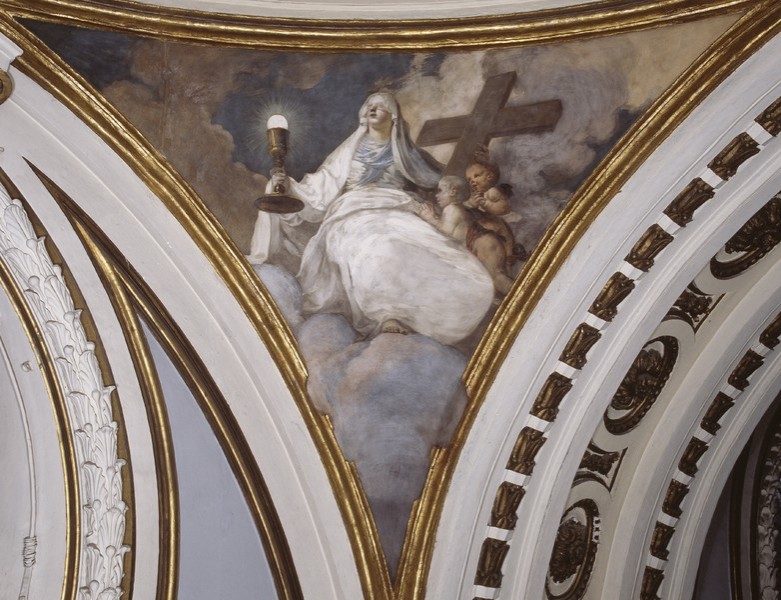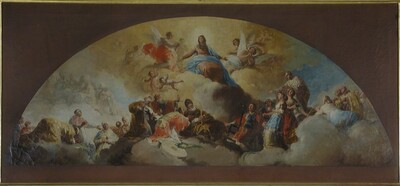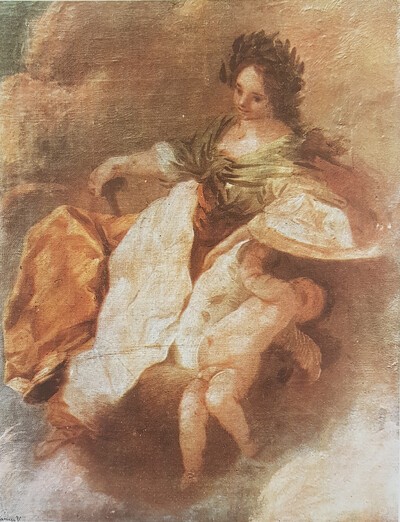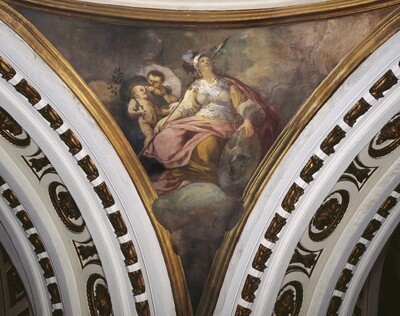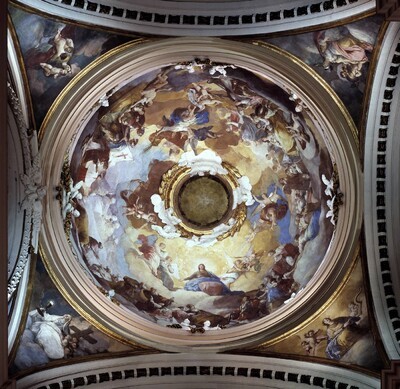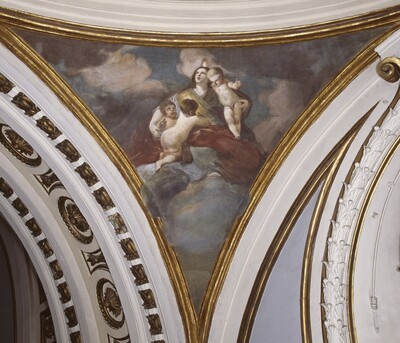- Cronología
- 1781
- Ubicación
- Basilica of Our Lady of the Pillar, Zaragoza, Spain
- Dimensiones
- 16 m2
- Técnica y soporte
- Fresco painting
- Reconocimiento de la autoría de Goya
- Documented work
- Titular
- Metropolitan Chapter of Zaragoza
- Ficha: realización/revisión
- 10 Oct 2010 / 13 Jun 2023
Goya had presented a first version of the sketches for the four pendentives of the cupola Regina Martyrum to the Building Committee of the Metropolitan Chapter of Zaragoza, but these were rejected on 10 March 1781. The second versions he submitted were accepted on 17 April, and Goya proceeded to paint the corresponding pendentive frescos, which represent allegories of four of the virtues: Faith, Patience, and Charity.
The representation of four virtues - two of the three so-called theological virtues, Faith and Charity; one of the cardinal virtues, Fortitude, and Patience) depict female figures dressed in vast mantles and seated on clouds. They are accompanied by the different attributes that identify them. The personifications are based on the iconography of the repertoire of allegories described in Cesare Ripa's Iconologia, a book containing many illustrations published in Europe from the end of the 16th century. Faith is depicted as a figure dressed all in white, carrying a chalice and the Sacrament in her right hand and a cross in her left. The veil which covers her head is particularly well executed.
There are clear similarities between this and the representation of the same virtue by Tiépolo which decorates the ceiling of the Throne Room of the Royal Palace in Madrid.
The Allegory of Faith is located on the north-east side of the cupola.
1940. Restored by Ramón Stolz.
1967. Restored by the Central Institute of Conservation and Restoration of Artistic and Archaeological works (Instituto Central de Conservación y Restauración de Obras de Arte y de Arqueología).
1981–1982. Restored by Carlos Barboza and Teresa Grasa.
December 2005 – February 2007. Restored by the Spanish Institute of Historical Heritage (Instituto del Patrimonio Histórico Español) funded by the Caja Madrid Foundation.
-
Restauración de la cúpula Regina MartyrumBasílica de Nuestra Señora del PilarZaragoza2007organized by the Fundación Caja Madrid and the Departamento de Conservación del Patrimonio Histórico Español. From March 29th 2007 to December 31st 2008
-
Vie et ouvre de Francisco de GoyaParísOffice du livre1970pp. 92, cat. 180
-
BarcelonaPolígrafa1970vol. I, p. 254, cat. 128
-
Regina Martirum GoyaZaragozaBanco Zaragozano1982
-
Los bocetos y las pinturas murales del Pilarcol. col. Mariano de Pano y RuataZaragozaCaja de Ahorros de la Inmaculada de Aragón1987pp. 52, 131-144
-
Goya y Aragón. Familia, amistades y encargos artísticoscol. Col. Mariano de Pano y RuataZaragozaCaja de Ahorros de la Inmaculada de Aragón1995pp. 127-141
-
Las pinturas murales de Goya en AragónMadridGobierno de Aragón y Electa España1996pp. 49-73
-
La cúpula Regina martyrum de la Basílica del Pilarcol. Colección Monumentos RestauradosMadridFundación Caja Madrid2008
